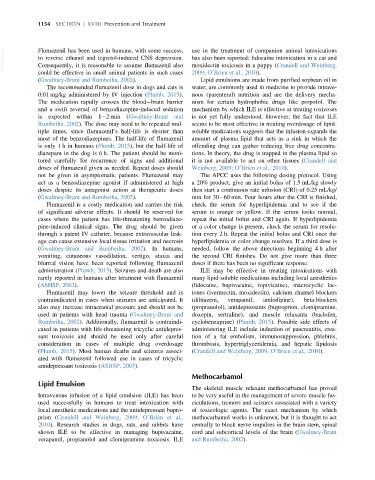Page 1223 - Veterinary Toxicology, Basic and Clinical Principles, 3rd Edition
P. 1223
1154 SECTION | XVIII Prevention and Treatment
VetBooks.ir Flumazenil has been used in humans, with some success, use in the treatment of companion animal intoxications
has also been reported: lidocaine intoxication in a cat and
to reverse ethanol and tegretol-induced CNS depression.
moxidectin toxicosis in a puppy (Crandell and Weinberg,
Consequently, it is reasonable to assume flumazenil also
could be effective in small animal patients in such cases 2009; O’Brien et al., 2010).
(Gwaltney-Brant and Rumbeiha, 2002). Lipid emulsions are made from purified soybean oil in
The recommended flumazenil dose in dogs and cats is water, are commonly used in medicine to provide intrave-
0.01 mg/kg administered by IV injection (Plumb, 2015). nous (parenteral) nutrition and are the delivery mecha-
The medication rapidly crosses the blood brain barrier nism for certain hydrophobic drugs like propofol. The
and a swift reversal of benzodiazepine-induced sedation mechanism by which ILE is effective at treating toxicoses
is expected within 1 2min (Gwaltney-Brant and is not yet fully understood. However, the fact that ILE
Rumbeiha, 2002). The dose may need to be repeated mul- seems to be most effective in treating overdosage of lipid-
tiple times, since flumazenil’s half-life is shorter than soluble medications suggests that the infusion expands the
most of the benzodiazepines. The half-life of flumazenil amount of plasma lipid that acts as a sink in which the
is only 1 h in humans (Plumb, 2015), but the half-life of offending drug can gather reducing free drug concentra-
diazepam in the dog is 6 h. The patient should be moni- tions. In theory, the drug is trapped in the plasma lipid so
tored carefully for recurrence of signs and additional it is not available to act on other tissues (Crandell and
doses of flumazenil given as needed. Repeat doses should Weinberg, 2009; O’Brien et al., 2010).
not be given in asymptomatic patients. Flumazenil may The APCC uses the following dosing protocol. Using
act as a benzodiazepine agonist if administered at high a 20% product, give an initial bolus of 1.5 mL/kg slowly
doses despite its antagonist action at therapeutic doses then start a continuous rate infusion (CRI) of 0.25 mL/kg/
(Gwaltney-Brant and Rumbeiha, 2002). min for 30 60 min. Four hours after the CRI is finished,
Flumazenil is a costly medication and carries the risk check the serum for hyperlipidemia and to see if the
of significant adverse effects. It should be reserved for serum is orange or yellow. If the serum looks normal,
cases where the patient has life-threatening benzodiaze- repeat the initial bolus and CRI again. If hyperlipidemia
pine-induced clinical signs. The drug should be given or a color change is present, check the serum for resolu-
through a patent IV catheter, because extravascular leak- tion every 2 h. Repeat the initial bolus and CRI once the
age can cause extensive local tissue irritation and necrosis hyperlipidemia or color change resolves. If a third dose is
(Gwaltney-Brant and Rumbeiha, 2002). In humans, needed, follow the above directions beginning 4 h after
vomiting, cutaneous vasodilation, vertigo, ataxia and the second CRI finishes. Do not give more than three
blurred vision have been reported following flumazenil doses if there has been no significant response.
administration (Plumb, 2015). Seizures and death are also ILE may be effective in treating intoxications with
rarely reported in humans after treatment with flumazenil many lipid-soluble medications including local anesthetics
(ASHSP, 2003). (lidocaine, bupivacaine, ropivicaine), macrocyclic lac-
Flumazenil may lower the seizure threshold and is tones (ivermectin, moxidectin), calcium channel blockers
contraindicated in cases when seizures are anticipated. It (diltiazem, verapamil, amlodipine), beta-blockers
also may increase intracranial pressure and should not be (propranolol), antidepressants (buproprion, clomipramine,
used in patients with head trauma (Gwaltney-Brant and doxepin, sertraline), and muscle relaxants (baclofen,
Rumbeiha, 2002). Additionally, flumazenil is contraindi- cyclobenzaprine) (Plumb, 2015). Possible side effects of
cated in patients with life-threatening tricyclic antidepres- administering ILE include induction of pancreatitis, crea-
sant toxicosis and should be used only after careful tion of a fat embolism, immunosuppression, phlebitis,
consideration in cases of multiple drug overdosage thrombosis, hypertriglyceridemia, and hepatic lipidosis
(Plumb, 2015). Most human deaths and seizures associ- (Crandell and Weinberg, 2009; O’Brien et al., 2010).
ated with flumazenil followed use in cases of tricyclic
antidepressant toxicosis (ASHSP, 2003).
Methocarbamol
Lipid Emulsion
The skeletal muscle relaxant methocarbamol has proved
Intravenous infusion of a lipid emulsion (ILE) has been to be very useful in the management of severe muscle fas-
used successfully in humans to treat intoxication with ciculations, tremors and seizures associated with a variety
local anesthetic medications and the antidepressant bupro- of toxicologic agents. The exact mechanism by which
prion (Crandell and Weinberg, 2009; O’Brien et al., methocarbamol works is unknown, but it is thought to act
2010). Research studies in dogs, rats, and rabbits have centrally to block nerve impulses in the brain stem, spinal
shown ILE to be effective in managing bupivacaine, cord and subcortical levels of the brain (Gwaltney-Brant
verapamil, propranolol and clomipramine toxicosis. ILE and Rumbeiha, 2002).

